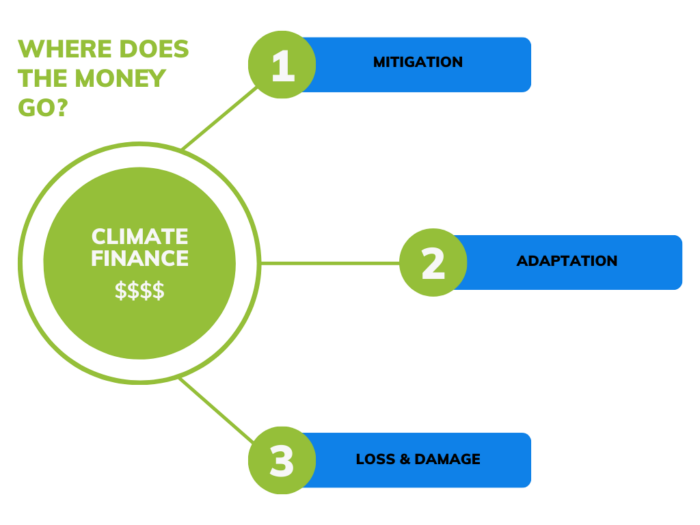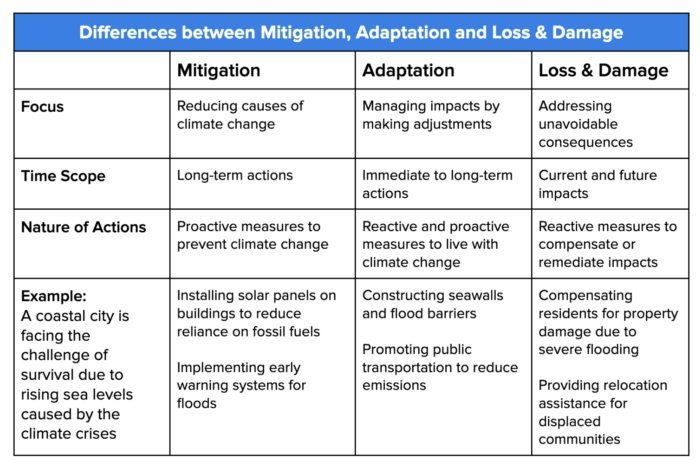This is part 1 of our climate finance series. Check out part 2 to learn who foots the bill, and how much needs to be paid.
An important key to tackling the climate crisis is money – what is known as climate finance. Climate activists are demanding it, governments and institutions are promising it. But what exactly is climate finance, and why is it so important for a just energy transition? We are answering all your burning questions starting with the basics:
1. What is climate finance?
Like all any human activity, taking actions to tackle the climate crisis is not possible without investing resources like time and money.
Climate finance is an umbrella term for all the different types of money that flows into supporting actions that safeguard our planet’s future. When we say money, we don’t just mean physical money like banknotes and coins, but also money-related activities like bonds (borrowed money), guarantees (back-ups in case a climate investment fails), carbon markets (putting a price on each ton of carbon emitted) and more.
The United Nations Framework Convention on Climate Change (UNFCCC), an international treaty among countries, offers a widely accepted definition: it is financing, whether local, national, or transnational, aimed at supporting actions to mitigate and adapt to climate change. You’ll notice thought there isn’t really a precise and universal definition for what counts as climate finance, only a broad one. This makes it difficult to measure and track all the funds flowing into climate action, and whether this money is really flowing to where it needs to go. But before we see where the money is invested, let’s look at where it actually comes from.
2. Where does the money come from?

Public Funds
Public funds for climate initiatives come from government budgets, which allocate money collected from taxes we pay. These funds are used for various climate-related projects, such as grants, subsidies, and direct funding. This money is used to finance projects in either local countries or goes to vulnerable nations for climate action, such as building resilient infrastructure or supporting agricultural practices to combat climate impacts. In our current world, most countries’ financial situations have been shaped by centuries of colonial extractivism in Asian, African, South American and the Pacific countries (the so-called Global South). Now its mainly the Global North governments that actually have the money and resources to not only tackle the climate crisis in their own countries but help out other countries as well.
Multilateral / Development Banks
Development banks, such as the World Bank and the Asian Development Bank (ADB), provide financing specifically for climate-related projects. They offer low-interest loans, grants, and technical assistance for large-scale infrastructure and development efforts. For instance, these banks finance renewable energy infrastructure projects, like wind farms in India or solar power plants in Thailand. The capital for these banks comes from member countries, private sector contributions, as well as financial markets. However, it is important that these banks provide climate money to countries who need it the most in the form of grants, so that the countries do not get trapped in cycles of debt which are notoriously difficult to escape, and take crucial money away from public resource spending.
Private Sector Investments
Private corporations are also investing money in climate action. These investments can include funding for energy projects, energy companies, and corporate loans. Let’s keep in mind though that its a lot of these same big corporations that are responsible for the climate crises and expansion of fossil fuels. Their real motivation isn’t to deliver real climate solutions over the long term, it’s to quickly maximise profits.
Instead of funding projects that help the communities most at risk, private money flows more to areas where profits can be increased. This often makes inequality worse, leads to greenwashing and false solutions and can force people from their lands. In fact, the negative climate impact of such big companies’ activities far outweighs the benefits from their ‘so called’ climate finance contributions. A massive example is Google and other tech giants heavily investing in nuclear energy and marketing it as a clean energy technology, whereas we know how risky nuclear energy actually is and how catastrophic its impacts can be.
Philanthropic Contributions
Foundations and charitable organizations provide grants and donations fund climate research, innovation, and advocacy efforts. For instance, the Bill & Melinda Gates Foundation supports research on sustainable agriculture practices and innovations in renewable energy technologies to address climate change impacts.
We need to look at these sources of climate finance, in particular, private financing and philanthropic money, with an extremely critical eye. Branded as altruistic climate finance, this money is often used to invest in ‘for-profit’ climate technologies with social costs, serving to keep the rich richer. True climate finance must serve the needs of people, with decisions led by the communities impacted most.
3. Where does the money go?
Climate finance serves three big climate action purposes. To talk the language of climate finance, you’ll need to grasp these three simple terms: mitigation, adaptation & loss and damage.

Mitigation
These are activities to reduce carbon emissions or pollution so we can keep global heating to a minimum and prevent the negative impacts of the climate crisis like heatwaves, floods, droughts, biodiversity loss, etc.
This can be done through investing in renewable energy sources (like solar and wind power) to eliminate reliance on polluting fossil fuels, reforestation projects to absorb CO2 and restore ecosystems, or electric vehicles to decrease emissions from transportation and more. While we need urgent investments in safe and affordable renewables, on the flip side, lots of money is also flowing into false mitigation projects like Carbon Capture and Storage, which are dangerous & polluting technologies.
Measuring our mitigation efforts: We also need to know if we are doing enough to keep away the harmful impacts of the climate crisis. So the international community measures progress on climate mitigation through an important climate goal set by climate scientists: limiting global heating to a maximum 1.5 degree celsius by 2100 to prevent climate damage beyond which there is no going back. And to reach this goal, we first need to reach net-zero, which means we cannot to add more carbon into the atmosphere than we are able to remove.

Adaptation
These measures help us cope better with ongoing or expected negative impacts of the climate crisis. It can look like planting drought-resistant crops to ensure food security in arid regions, building green roofs in urban areas to reduce heat island effects and manage stormwater or constructing flood barriers to protect coastal communities from rising sea levels. Unfortunately, less climate finance is flowing towards adaptation measures that are needed, because unlike mitigation projects, adaptation projects do not usually offer ways to make quick profits for their investors.
At the moment, adaptation is the need of the hour as several small island nations are facing threats to their survival from climate impacts, like rising sea levels. Adaptation measures, such as setting up resilient infrastructure and early warning systems, are crucial to protect lives. While certain nations have an urgency to act now, the use of fossil fuels is inextricably directly linked to each person’s well-being. Learn more about the impacts of fossil fuels on us.
Loss and Damage
This refers to the money that goes into recovering from the unavoidable impacts of the climate crisis like damages resulting from extreme weather events like cyclones, droughts and heatwaves. In some cases, damages may permanently alter places; for example, droughts shrinking water supplies or turning productive farms into barren land. Like adaptation, Loss and Damage projects are not getting a big enough share of climate finance either, even though its urgently needed, as these impacts are currently harming vulnerable communities the most.
If you’re still confused, check out this handy chart to understand the differences between types of climate action that need finance:

4. What is an example of climate financing in action?
Scenario: Imagine a remote village without reliable electricity, reliant on polluting sources like kerosene lamps. This community faces health risks from indoor air pollution and economic burdens due to the high cost of kerosene. Recognizing the need for a sustainable solution, a local NGO collaborates with an international development agency to secure climate finance.
Assembling climate finance: The funding comes from a combination of sources. An international development agency provides a grant to cover the initial costs of the project, including equipment and installation. The NGO contributes additional funds and trainings to support training and maintenance, ensuring the community can manage the system independently.
Putting climate finance to use: With these funds, the NGO initiates the project, involving extensive community consultations and volunteer participation. Through collaborative efforts with local residents, the NGO establishes a solar microgrid system in the village ensuring that local needs and perspectives are fully integrated into the project’s design and implementation. The solar microgrid system collects energy from the sun to power homes and businesses in the village.

Benefits: The project not only provides cleaner and reliable electricity but also replaces the need for kerosene lamps, significantly reducing greenhouse gas emissions. This shift contributes to global mitigation efforts by cutting the community’s carbon footprint. Additionally, the solar microgrid enhances the village’s resilience to energy insecurity, a crucial aspect of climate adaptation. Reliable electricity supports better healthcare, education, and economic opportunities, improving overall quality of life.
While the primary focus is on mitigation, the project indirectly addresses loss and damage. By preventing health issues related to kerosene use and reducing the economic strain on households, the village avoids long-term costs associated with healthcare and environmental degradation.
Learning: In this way, climate finance from diverse sources enables the village to transition to sustainable energy, showcasing the powerful impact of coordinated financial support in fostering resilient and eco-friendly communities. Check out a real-life example of a similar story in Uganda.
Conclusion
In reality, many, many small-scale and large-scale projects across countries, particularly in the Global South need to be urgently sponsored. This short video is great to delve deeper into the basics of climate finance, and share within your circles:
In the next part of this series, we explore how international institutions are coming together to ensure there is a sufficient flow of money for mitigation, adaptation and loss & damage projects around the world.
Sources: